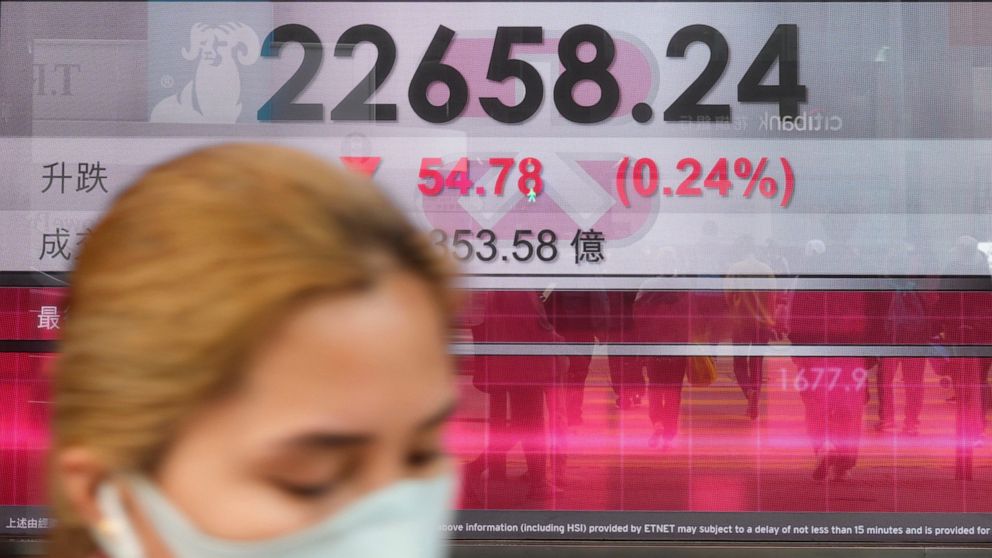Global shares mixed as Russia, Ukraine plan further talks
World shares are mixed after talks between Russia and Ukraine aimed at ending the war just yielded an agreement to meet again
TOKYO — World shares were mixed Tuesday after talks between Russia and Ukraine aimed at ending the war just yielded an agreement to meet again.
European markets opened mostly lower while Asian shares and U.S. futures were mostly higher. Oil prices rose.
A 40-mile convoy of Russian tanks was threatening Ukraine’s capital Kyiv in the sixth day of the war as the Kremlin grew increasingly isolated.
A first, five-hour session of talks ended with an agreement to another meeting in coming days, though embattled Ukrainian President Volodymyr Zelenskyy said he believed stepped-up shelling by Russian troops was designed to force him into concessions.
Russia is a major energy producer and surging oil prices and increasing financial pressure from the U.S. and allies on Russia for its invasion of Ukraine were adding to uncertainty about the global economic outlook.
France’s CAC 40 lost 0.6% to 6,622.35. Germany’s DAX shed 0.7% to 14,357.77, while Britain’s FTSE 100 edged 0.1% higher, to 7,467.27.
On Wall Street, the futures for both the S&P 500 and the Dow industrials were 0.2% higher.
“While the ceasefire talks at the Belarus-Ukraine border ended, the military fires certainly have not ended by any means alongside sanctions being raised further,” Tan Boon Heng at Mizuho Bank in Singapore said in a commentary.
Japan’s benchmark Nikkei 225 gained 1.2% to finish at 26,844.72. Australia’s S&P/ASX 200 surged 0.7% to 7,096.50. Hong Kong’s Hang Seng added 0.2% to 22,761.71, while the Shanghai Composite rose nearly 0.8% to 3,488.83. Markets were closed in South Korea for a holiday.
“The market’s focus will continue to be on geopolitical tensions, at least in the short term,” Anderson Alves of ActivTrades said in a report.
The value of the Russian ruble plunged to a record low after Western countries moved to block some Russian banks from a key global payments system. On Monday, the U.S. Treasury Department announced more sanctions against Russia’s central bank.
The ruble was trading at 104.51 to the dollar Tuesday, up 3.2% from its nadir of 108.02 per dollar on Monday.
Governors and lawmakers in numerous U.S. states, seeking to add to the financial squeeze on Russia, were taking steps to pull state pension and treasury funds out of investments in Russian-held entities or Russian companies supporting the war.
Various companies have announced plans to scale back or pull out from ventures in Russia, or to suspend operations in Ukraine due to the conflict.
Investors already were on edge before Russia’s invasion in anticipation of the Federal Reserve’s plans to hike interest rates for the first time since 2018 to counter inflation.
The Fed is treading a tightrope, needing to raise rates enough to curb inflation but not by so much as to choke the economy into a recession. Higher rates also put downward pressure on various investments from stocks to cryptocurrencies.
The war in Ukraine is raising expectations that the Fed and other central banks may have to adopt a gentler approach to raising interest rates than earlier expected.
Seeking safer returns, investors have plowed into U.S. government bonds. The yield of the 10-year Treasury fell 0.15 percentage points Monday to 1.83%, its biggest drop since the omicron coronavirus variant first rattled investors.
The 10-year Treasury was at 1.84% early Tuesday.
Fed Chair Jerome Powell is to testify before Congress later this week and could offer clues on the path ahead. A report on Friday will also show whether strength in the U.S. jobs market continued in February, allowing the Fed more leeway to raise rates.
In energy trading, benchmark U.S. crude added $2.50 to $98.22 a barrel in electronic trading on the New York Mercantile Exchange. It jumped $4.13 to $95.72 on Monday.
Brent crude, the international standard, rose $3.16 to $101.13 per barrel. Oil prices on both sides of the Atlantic have been surging amid concerns about what will happen to crude supplies.
In currency trading, the U.S. dollar fell to 114.93 Japanese yen from 114.99 yen. The euro rose to $1.1225 from $1.1219.
![]()


